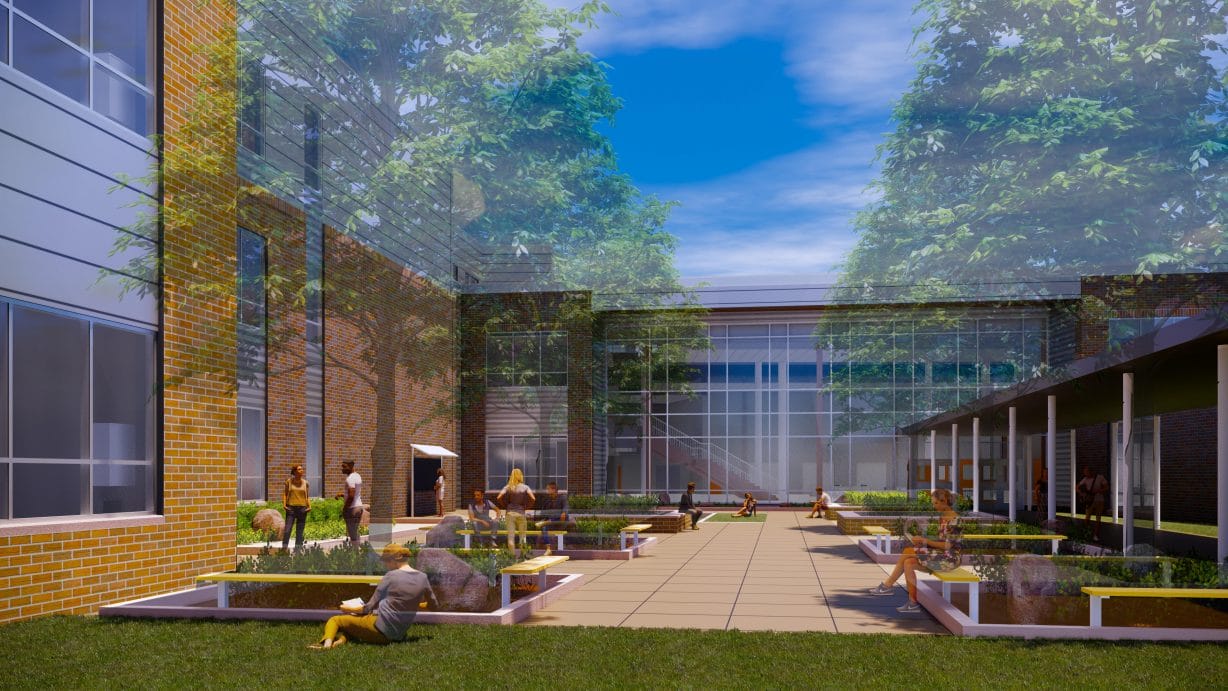
By Randi B. Hagi, assistant editor
Harrisonburg’s new school will cost no more than $87.2 million, the school board decided in a unanimous vote at its meeting Tuesday, as it recommended updated designs to go to the city council for its final approval.
Specifically, the price includes:
- $16.53 million for the site work
- $63.26 million for the building.
- And $7.45 million in design costs.
That $87.2 million is a “guaranteed maximum price,” which Jim Delucas, chief development officer at Nielsen Builders, Inc., presented to the board, meaning that unless the school board decides to change the design, the final cost cannot exceed that amount. And it still could cost less if some aspects of construction come in under budget.
The price is not quite $2 million over what Grimm + Parker Architects, who worked with Nielsen on the now-approved design, quoted the school board in January. And that price, of $85.5 million, did not include the $5 million football stadium complex or geothermal energy wells that were included in the design approved on Tuesday.
Other design details that Delucas announced include:
- Baseball, softball, tennis, and multipurpose turf facilities,
- A walking trail to connect to a city shared use path,
- An entrance dubbed “East Kaylor Road” near the Pano’s property,
- Three stories of academic wings, which can be expanded upon in the future
- And a core capacity of 1,500 students, meaning that many students can fit in central spaces like the cafeteria.
“I’m really pleasantly surprised by the final number,” school board member Nick Swayne said. “I thought it was going to be higher. And if you compare this to high schools that have been built recently in Virginia, we’re about $15-$20 million under.”
The price, design drawings and construction schedule go to the city council for a vote on Nov. 12. Pending the council’s approval after a second reading in the Nov. 26 meeting, Nielsen will break ground on the site off of South Main Street before the end of 2019.
Delucas said the firm already submitted the site plan to the city’s Community Development office for its approval. The idea, he said, is that “we’ll have that permit in hand, and we would like to start Dec. 16, pushing dirt … to be in school for Aug. 2022.”
The school board members eagerly competed to make the motion and second the resolution approving the new high school.
“It’s been a long time coming,” Board Chair Deb Fitzgerald said, before the unanimous vote was taken to a smattering of applause.
“It feels like a safe price,” said Obie Hill, another board member.
He recognized some of his colleagues from the “For HHS2” movement in the audience. The grassroots group formed in October 2017 to advocate for the construction of the new high school.
“I’m sure they’re happy to see this finally come to fruition,” Hill said.
“It’s a wonderful example of partnering and cooperation from all the stakeholders involved,” Board Vice Chairman Andy Kohen said.
‘Home-grown and home-built’
Delucas said that including subcontractors in the early stages of the design process helped them make accurate cost estimates.
“It’s been a really collaborative effort between the school board, the students, the teachers, the faculty, our design partners, and our contractors that we have on board. Everybody has some skin in this game,” Delucas said.
Various firms including Grimm + Parker Architects, Valley Engineering (based in Mt. Crawford), Broadway-based Trumbo Electric, and Riddleberger Brothers, a mechanical contractor based in Mt. Crawford, all contributed to the designs.
Delucas said 55 percent of the project’s contractors are based in Harrisonburg or Rockingham County, 75 percent of them are in the Shenandoah Valley and 95 percent of them are in Virginia.
“It’s home-grown and home-built,” Fitzgerald said.
Craig Mackail, chief operating officer, said additional “soft costs,” such as furniture, fixtures and equipment would cost the school about $8 million.
“That’s standard,” Mackail said.
Journalism is changing, and that’s why The Citizen is here. We’re independent. We’re local. We pay our contributors, and the money you give goes directly to the reporting. No overhead. No printing costs. Just facts, stories and context. Thanks for your support.














